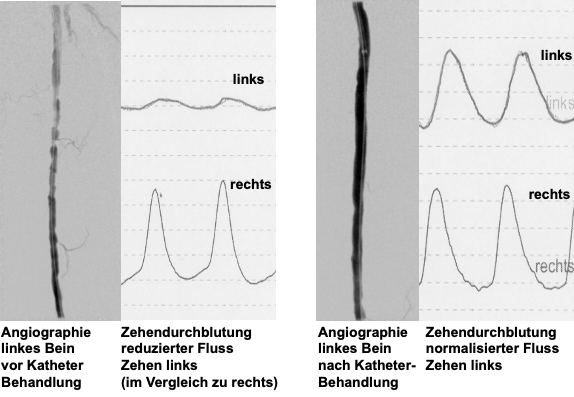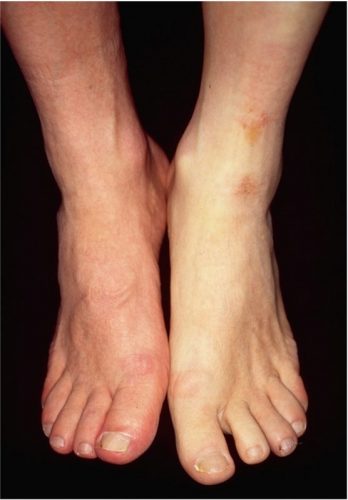Ultrasound examination for early detection of dilatation of the abdominal aorta (abdominal aortic aneurysm screening, recommended for all men > 65 years of age) is also useful, as it often results in circulatory disorders of the legs and the aneurysm must be treated in the sense of a circulatory disorder, as it is usually an expression of advanced arteriosclerosis (exception: congenital in young people).
Circulatory disorder of the brain – stroke prophylaxis
In order to be able to assess the blood flow situation to the brain, a duplex sonographic ultrasound examination of the carotid arteries is recommended. Here, the carotids can be well assessed, on the one hand when it comes to the start of arteriosclerosis treatment (usually decision-making before initiating therapy with a cholesterol-lowering drug), on the other hand, a circulatory disturbance to the brain can be directly detected here. If a carotid artery is critically narrowed or if the first symptoms appear, the circulatory disorder must be treated immediately and the affected vessel must be operated on or treated with a stent. In the context of stroke treatment, an examination of the carotid arteries is always indicated, since carotid stenosis is a frequent cause of apoplexy and the circulatory disturbance can be treated well.
Treat circulatory disorders in the area of the hands
A circulatory disorder of the hands is often functionally caused. This means that an external stimulus, usually cold or psychological stress, causes an excessive reaction of the smallest vessels, so that the circulatory disorder causes the fingers to turn blue or white. When warm, the supposed circulatory disorder of the fingers no longer causes symptoms. In most cases (typical for Raynaud’s syndrome), the circulatory disorders can be easily treated by appropriate cold prophylaxis or medication. In contrast, organically caused circulatory disorders of the hands and fingers are often characterized by pain, a feeling of cold, or restricted movement/lack of strength. If an arterial occlusion is the cause of the symptoms, the circulatory disorder must be treated immediately, usually with medication and/or catheter procedures.
How are circulatory disorders treated?
The most frequent cause of a circulatory disorder is arteriosclerosis. The first priority in therapy here is optimal adjustment of cardiovascular risk factors and consistent renunciation of nicotine. In addition to active nicotine consumption, manifest diabetes mellitus is one of the main risk factors. Therefore, optimal metabolic control is essential. In case of a relevant circulatory disorder, platelet aggregation inhibitors (e.g. ASA) or other blood thinners are often used. In addition to conservative, drug treatment options, circulatory disorders are primarily treated with catheter procedures. If this is not technically possible, a surgical presentation is made for surgical treatment (e.g. bypass).
What complaints or symptoms does a circulatory disorder in the brain cause?
Typical precursors of a stroke are passive circulatory disturbances in the brain, which typically manifest themselves in a focal neurological deficit: Visual disturbances in one eye (“as if blind, everything is black”) that are of short duration, after which vision returns to “normal.” Likewise, reversible speech disorders, a drooping corner of the mouth, or sensory disturbances in one arm may become apparent. Dizziness or blurred vision in one eye, on the other hand, are not typical symptoms of a circulatory disorder in the brain. If a stroke then occurs on the basis of a circulatory disorder in the brain, the symptoms are no longer reversible and neurological deficits or paralysis occur.
What can you do for the blood circulation?
In order to influence the vascular aging process, arteriosclerosis, as positively as possible, it is recommended to lead a sporty, active lifestyle with the aim of attaining a normal weight and abstaining from nicotine. Blood lipids, especially serum cholesterol, should be optimally adjusted, as should blood pressure and blood sugar. Furthermore, moderate physical activity is recommended (e.g. 3 x weekly 30 min. light endurance training). If there are already deposits on the vascular system (so-called plaque formation), it is advisable to start therapy with a cholesterol-lowering agent in order to positively remodel and stabilize the already existing plaques. This is because plaque rupture often leads to a carryover of thrombogenic material, which can then block a peripheral artery in the brain. To counteract these processes, there is also an indication for platelet inhibition, especially in the case of plaques or pre-existing constrictions in the area of the carotid arteries.
What can you do yourself against circulatory disorders of the legs?
If there is a manifest circulatory disorder of the legs and active nicotine consumption, this must be permanently discontinued. The circulatory disorder of the legs then corresponds to a so-called “smoker’s leg”. In addition to drug treatment and a healthy lifestyle, you can treat your circulatory disorder yourself by exercising your legs. This is a structured walking training, at least 3 times a week better a daily 30 minute- walk. If pain starts to occurs, which is typical for a circulatory disorder, training is continued until the pain increases, then standing still until the pain passes again and then walking is continued. In this way, bypass circuits can be formed that can compensate for vascular occlusion.
Walking is particularly important here; cycling does not achieve the desired effect. With walking training alone, the maximum walking distance can be extended and the quality of life significantly improved. To document the success of the treatment, keeping a diary in which the maximum walking distance per training unit is recorded has proven useful. If there is already a pronounced circulatory disorder of the legs, it is particularly important to ensure consistent protection of the extremities. The feet and toes must always be kept warm. Wool socks are much more suitable than pure cotton, which cannot retain heat. Suitable footwear is particularly important to prevent minor injuries. Likewise, professional, medical foot care, wearing shoes with soft soles, etc. is recommended.


